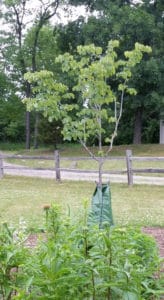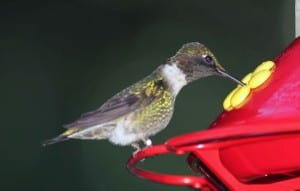
By Jennifer Fairfield
July should be harvest time for many crops. Spring crops, such as lettuce, spinach, and peas will mostly finish producing this month, while summer crops, such as zucchini, cucumbers, and early tomatoes will just be getting started by the end of the month.
Garlic
Garlic is generally ready for harvest between mid-July and early August, depending on the variety and when it was planted (fall vs. spring). If possible, stop watering your garlic about three weeks before you expect to be harvesting (I say “if possible” because my garlic is in the same bed as other plants, and I don’t want to deprive those plants of water, which makes it hard to stop watering the garlic, but it hasn’t really caused me any problems with my garlic).
You can tell that it’s ready to be harvested by the foliage. When about one-third of the leaves have yellowed and withered, it’s time to check on your bulbs. Gently wipe some of the soil away from a bulb, and check the size and form of your garlic. If it looks like a good size, it’s ready to come out. If not, leave it for another few days to a week, and check again. Don’t leave garlic in the ground too long past peak harvest time though, as this could lead to rotting.
Succession Crops
July is also a time for planting and starting new seedlings for fall harvest. If you want to have broccoli and cabbage for fall, start your own inside by no later than July 10, transplanting the seedlings into your garden when they are four to six weeks old. They should be ready for harvest by early October. These can be good “succession crops” to be put into the garden in place of things like onions and garlic, once those have been harvested.
You can plant late season successions of lettuce, spinach, peas, beets, carrots, and Swiss chard at the end of the month, to be ready for picking before it gets too cold.
Wait to plant radishes until early or mid-August, as it will generally still be too hot at this point for these cool-weather lovers (they mature very quickly, and will bolt in the heat of August before they can get big enough for eating).
Water
Don’t forget to water your veggie garden regularly. Your plants generally need about an inch of water every week, when Mother Nature isn’t providing it. A good soaking once a week is better than a little bit every day or two, but when the temps are really high, and especially when accompanied by wind, a little more water is even better. Don’t overdo it, but definitely make sure that your soil doesn’t totally dry out between watering. That’s a great way to stress your plants.
Side Dress
Side dress your summer crops this month. Side dressing is just the simple act of giving your plants a mid-season boost of fertilizer. It provides the plants with a little extra food when they need it most – as they are doing the most growing and as they are producing flowers and fruit. By the time they are ready to start putting out flowers, the plants have used up most of the available nutrition in your garden. Providing a little more fertilizer at this point will make a big difference in whether your garden produces in abundance, which is the point of all this work, isn’t it?
The term side-dressing really just means to apply fertilizer around the plant, in the root zone. Don’t just sprinkle it on top, though – carefully work it into the top inch or so of soil. Fertilizer left on top of the soil often will just wash away before it can break down and be useful to the plant. Don’t get any closer than about four inches from the stem of the plant, as you want the food to be available to the new root growth as the plant is growing and putting out more roots.
Fungicide Spraying
Keep up with your program of fungicide spraying. There are a lot of diseases that really get going as summer progresses, especially on tomatoes, cucumbers, and squash. Michigan State University Extension has already confirmed cucumber downy mildew in Monroe county, which means that it will be showing up in all of our gardens soon.
Treating your plants with an organic fungicide, such as the Seranade Garden Disease Control that we carry at the store, on a regular basis, can help keep them from succumbing to disease, which means that you might actually get to eat a lot of what you planted! If you’re not sure how to tell what’s ailing your plants, Cornell University’s Vegetable MD Online is a great resource. But don’t wait until you see disease to treat it – most of the diseases can’t really be treated, but need to be prevented. So start treating your plants now, if you haven’t already.
In the flower garden:
Much like in the veggie garden, keeping insects under control has been a challenge lately. In my flower gardens, I’m seeing aphids on my asters, sawfly larva on my hardy hibiscus, and Japanese beetles on everything! I’ve relied on Espoma’s Insect control for the aphids and sawfly larva, but the best way to deal with Japanese beetles is to simply pluck them off the plants and drop them into a bucket of soapy water. The soap coats their wings, making it impossible for them to get out of the water, and they eventually drown. The best time of day to do this is in the afternoon, when it has warmed up. Getting as many as you see on a daily basis will help keep them under control. If you wait too long, the few you have will suddenly turn into a mob, as they don’t like to dine alone, and once one has found your garden, it will send out signals to all its friends to come and join it.
If you are using insecticides of any kind, be aware of when to apply them. Different insects are active at different times of day, and some pesticides work best if sprayed directly on the pest. Also, be aware of bee activity in your flowers, and don’t spray any insecticides when you see bees around, or at least do targeted spraying, instead of broadcast spraying, to avoid killing bees. Always read labels completely, and follow instructions carefully. Regardless of whether you use organic or non-organic products, they are poisons, and can be harmful to bees, as well as you, if not used properly.

Fertilize Roses
Be sure to fertilize roses throughout the month, but stop fertilizing at the end of the month to allow the new growth to harden off before winter. Also remove diseased leaves immediately, and pick up any that have fallen. Aphids and mites can be major rose pests, and can cause serious damage if not kept under control. Careful spraying when these pests are spotted is generally all that is necessary. These tasks, along with regular fungicide spraying will help keep your roses healthy.
As in your vegetable garden, keep weeds under control in the flower garden, so they don’t compete with your flowers for moisture and nutrients.
Cut back perennials that have finished blooming.
To keep your potted annual flowers looking great all summer long, be sure to fertilize them. With frequent watering, fertilizer tends to get flushed out of the container, so regular feedings are a must. Also, don’t forget to deadhead. By removing dead flowers, you encourage the growth of new ones throughout the season.
And don’t forget to water
Regularly water any trees and shrubs planted this year. And if our dry conditions keep up, consider watering any trees and shrubs you planted in past years to keep them from becoming stressed leading into winter. Tree watering bags can be a life-saver (literally for your trees, and figuratively for you) during extended dry periods like we had in June. You only have to fill them up once or twice per week, and they slowly water your trees for you.
Do not apply fertilizer to trees or shrubs after the 4th of July, to avoid a flush of new growth that doesn’t have time to harden before winter.
Finish up pruning of trees and shrubs this month or early next. Pruning too late in the season can encourage new growth that will not have time to harden off before winter sets in.
Lawn:
When mowing this summer, leave your grass between 3 and 4 inches tall, and only cut off the top third of the blades at each mowing. Keeping your grass a little higher will help it retain moisture during the hot, dry summer we usually have, and will help suppress weeds.
The larva of the nasty Japanese beetles we’re seeing now are the grubs that will be eating your grass roots later in the season, causing patches of brown, dead grass that, unlike grass that is dormant, won’t be growing back. If you are seeing a lot of adult beetles now, and can’t keep them under control (a next-to impossible task), the best thing you can do is to control the larva. Milky spore is a long-term control option that we carry in the store. Milky spore is a bacterial disease that kills the grubs when they ingest it. It can be effective for many years, but also takes a few years to kill off all of the grubs, so don’t expect immediate results.

For the Birds:
Keep your birdbaths full, and consider putting out additional baths or even filling things like overturned trash can lids or large saucers with water for them. The dry conditions we generally have in summer are as difficult on birds as on our gardens, and they are going to be looking for water wherever they can find it. One place they may try to relieve their thirst is in your garden – by biting into and sucking out the juice of your crops. Making sure they have a consistent source of water may save your harvest. Just be sure to dump the water and refill it every day, to discourage mosquitoes from laying eggs.
Keep hummingbird feeders cleaned out and filled. Sugar water left out in the heat for a number of days can breed bacteria that is harmful to the beautiful birds visiting your feeders, so be sure to clean them out every few days.












